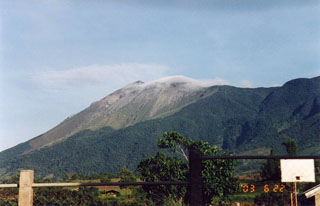Report on Kanlaon (Philippines) — 21 June-27 June 2006
Smithsonian Institution / US Geological Survey
Weekly Volcanic Activity Report, 21 June-27 June 2006
Managing Editor: Sally Sennert.
Please cite this report as:
Global Volcanism Program, 2006. Report on Kanlaon (Philippines) (Sennert, S, ed.). Weekly Volcanic Activity Report, 21 June-27 June 2006. Smithsonian Institution and US Geological Survey.
Kanlaon
Philippines
10.4096°N, 123.13°E; summit elev. 2422 m
All times are local (unless otherwise noted)
Minor steam-and-ash emissions that were observed from Canlaon during 21-24 June reached a maximum height of 1.5 km above the summit (12,900 ft a.s.l.) and drifted NW and SW. Light ash fall was observed approximately 25 km SW in the municipality of La Castellana. The alert status remained at Level 1, which restricts activity within 4 km of the summit.
Geological Summary. Kanlaon volcano (also spelled Canlaon) forms the highest point on the Philippine island of Negros. The massive andesitic stratovolcano is covered with fissure-controlled pyroclastic cones and craters, many of which are filled by lakes. The largest debris avalanche known in the Philippines traveled 33 km SW from Kanlaon. The summit contains a 2-km-wide, elongated northern caldera with a crater lake and a smaller but higher active vent, Lugud crater, to the south. Eruptions recorded since 1866 have typically consisted of phreatic explosions of small-to-moderate size that produce minor local ashfall.
Source: Philippine Institute of Volcanology and Seismology (PHIVOLCS)

